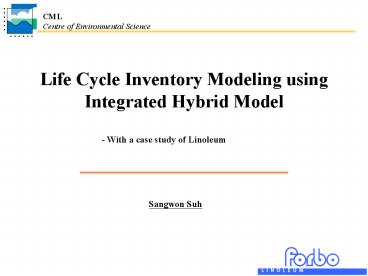Life Cycle Inventory Modeling using Integrated Hybrid Model - PowerPoint PPT Presentation
Title:
Life Cycle Inventory Modeling using Integrated Hybrid Model
Description:
Life Cycle Inventory Modeling using Integrated Hybrid Model - With a case study of Linoleum Sangwon Suh Reference Lave et al., 1995 Lenzen, 2001 Estimated truncation ... – PowerPoint PPT presentation
Number of Views:88
Avg rating:3.0/5.0
Title: Life Cycle Inventory Modeling using Integrated Hybrid Model
1
Life Cycle Inventory Modeling using Integrated
Hybrid Model
- With a case study of Linoleum
Sangwon Suh
2
1. Introduction
- Calculated truncation in SETAC LCI
Estimated truncation 50 952
Reference Lave et al., 1995 Lenzen, 2001
Method 1st order upstream 3rd order (energy)
3
1. Introduction
Lave et al., 1995
Lenzen, 2001
4
1. Introduction
Alternative Input-output based LCI
Moriguchi et al., 1993 Hendrickson et al,
1998 Joshi, 2000
5
1. Introduction
Activated carbon and charcoal Alkali metals
Alumina Aluminum chloride Aluminum compounds
Aluminum hydroxide (alumina trihydrate)
Aluminum oxide Aluminum sulfate Alums Ammonia
alum Ammonium chloride, hydroxide, and molybdate
Ammonium compounds, except for fertilizer
Ammonium perchlorate Ammonium thiosulfate
Barium compounds Bauxite, refined Beryllium
oxide Bleach (calcium hypochlorite), industrial
Bleach (sodium hypochlorite), industrial
Bleaches, industrial Bleaching powder,
industrial Borax (sodium tetraborate) Boric
acid Boron compounds, not produced at mines
Borosilicate Brine Bromine, elemental Calcium
carbide, chloride, and hypochlorite Calcium
compounds, inorganic Calcium metal Carbide
Catalysts, chemical Cerium salts Cesium metal
Charcoal, activated
SIC 2819- Industrial inorganic chemicals, NEC
182 items
6
1. Introduction
- Objectives
- Systematic LCI modeling Integrated hybrid
model - Empirical test using existing case study
7
2. Methodology
Hybrid LCI modeling
- Integrating computational structure of
LCI Heijungs, 1994 Physical unit/operation
time IOA Stone, et al., 1963 Monetary
unit/total production
Full interaction between processes and economy
8
2. Methodology
Hybrid matrix
9
Lacquer Production
0.263 Solvent
Industrial Org.Chem
0.031 Ind.Bld
Chem.Ind. Installatn
10
2. Methodology
-1
Technology matrix of P
Outflows from P
Final demand
Total intervention
Intervention by IO comm.
Intervention by processes
Inflows from IO
Technology matrix of IO
0
11
2. Methodology
- Required treatment
- IO part
- Inclusion of domestic and imported capital
- and current commodity
- 2. Price update the base year of the IO table
? current price - Subtraction of the portion of commodity flows
represented - by the product based system
- LCA part
- Allocation
- Price adjustment (consumers price vs. producers
price)
12
3. Case study
- Linoleum Gorree, et al., 2000
- Main data gaps
- - production transportation of
- pesticides, fertilizer S, additives,
solvent, - adhesives, catalysts
- - Capital goods
13
3. Case study
Procedure
Cost composition table/cost estimation for
cut-offs Capital requirements estimation Link
estimated cost to each IO cell
14
3. Case study
- Cost composition table
- Capital requirements estimation
- Linseed oil, Tall oil, (12 major
ingredients) - Catalysts, fertilizer S, (8
cut-off flows) - Industrial building, material
handling equipment,(3 capitals) - Linseed oil,
Tall oil, (12 major ingredients)
15
3. Case study
- 3 Cases
- - Baseline (Existing LCI)
- - Hybrid (Cut-offs and capitals 38 links)
- IO LCI (Miscellaneous floor coverings)
16
4. Result
17
4. Result
Summary
Percent change
Baseline Hybrid Max IO LCI
0 5 73 (avg. 18) -85 124 (avg. 3)
18
4. Result
Sources of difference
Process based LCA IO based LCA Truncation Tr
uncation Incomplete data Incomplete
data Aggregation Base year
difference Price difference Use of IO
based result should be limited
19
5. Conclusion
Conclusion
- Both process and IO based LCI suffer from their
inherent problems truncation and aggregation
2. Hybrid LCI technology matrix of LCI be fully
integrated to national
accounts
20
5. Conclusion
3. Hybrid method as worked out capturing most of
the flows without loss of process specific
data
4. Limitations of this study - IO data only
covers national economy - Inclusion of
capital goods can be improved
21
Software information
Missing Inventory Estimation Tool (MIET)
Download _at_ http//www.leidenuniv.nl/cml/ssp/softwa
re/miet CMLCA Download _at_ http//www.leidenuniv
.nl/cml/ssp/software/cmlca































